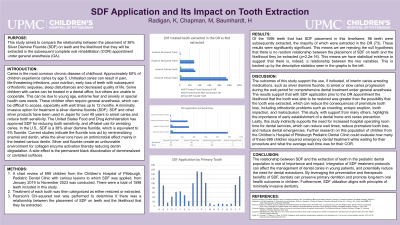Caries
253 - SDF Application and Its Impact on Tooth Extraction


Kylie D. Radigan, DMD
Pediatric Dental Resident
Children’s Hospital of Pittsburgh of UPMC, Pittsburgh, PA
Lake Erie College of Osteopathic Medicine School of Dental Medicine
Pittsburgh, Pennsylvania, United States- MC
Mary Chapman, DDS
UPMC Children's Hospital of Pittsburgh
- MC
Mary Chapman, DDS
Attending, Research Mentor
UPMC Children's Hospital of Pittsburgh
Pittsburgh, Pennsylvania, United States - HB
Heather Baumhardt, DDS
Program Director
UPMC Children's Hospital of Pittsburgh
Pittsburgh, Pennsylvania, United States
Presenting Author(s)
Co-Author(s)
Research Mentor(s)
Program Director(s)
Purpose: This study aimed to compare the relationship between the placement of 38% Silver Diamine Fluoride (SDF) on teeth and the likelihood that they will be extracted in the subsequent complete oral rehabilitation (COR) appointment under general anesthesia (GA). SDF is used to control early childhood caries, arrest root caries, prevent fissure caries and secondary caries, desensitize hypersensitive teeth, re-mineralize hypo-mineralized teeth, and detect carious tissue during excavation. SDF includes silver, an antimicrobial that inhibits cariogenic biofilm, and Fluoride, which promotes remineralization and inhibits teeth demineralization. With increasing wait times for general anesthesia treatment appointments, early SDF application could be the difference between tooth extraction and restorability.
Methods: A chart review of 699 children from the Children’s Hospital of Pittsburgh, Pediatric Dental Clinic with carious lesions to which SDF was applied, from January 2019 to November 2023 was conducted. There were a total of 1598 teeth included in this study.
Treatment of each tooth was then categorized as either restored or extracted.
Pearson's Chi-squared test was performed to determine if there was a relationship between the placement of SDF on teeth and the likelihood that they be extracted.
Results: Of the 1598 teeth that had SDF placement in this timeframe, 96 teeth were subsequently extracted, the majority of which were extracted in the OR (73). These results were significantly significant. This means we are rejecting the null hypothesis that there is no random relationship between the placement of SDF on teeth and the likelihood they be extracted (p=2.2e-16). This means we have statistical evidence to suggest that there is, indeed, a relationship between the two variables. This is backed up by the descriptive statistics seen in the graphs to the left. X2 = 96.15, df = 1, P < 2.2e-16
Conclusions: The relationship between SDF and the extraction of teeth in the pediatric dental population is one of importance and impact. Integration of SDF treatment protocols can affect the management of dental caries in young patients, and potentially reduce the need for dental extractions. By leveraging the preventative and therapeutic benefits of SDF, dentists can preserve primary dentition and promote long-term oral health outcomes in children. Furthermore, SDF utilization aligns with principles of minimally invasive dentistry.
Identify Supporting Agency and Grant Number:

.jpg)